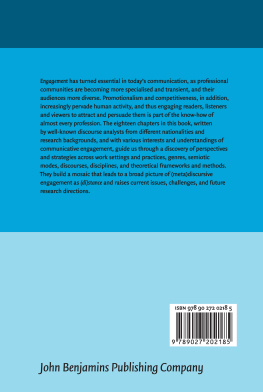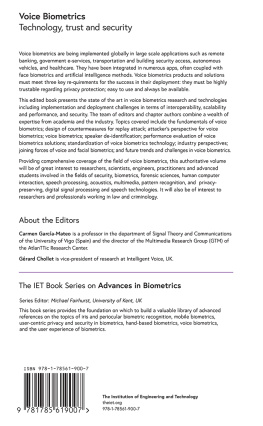

Engagement in Professional Genres
Carmen Sancho Guinda Universidad Politcnica de Madrid
doi: 10.1075/pbns.301
ISBN: 978 90 272 6294 3 (ebook)
Cataloging-in-Publication Data available from Library of Congress:
LCCN 2018046661
2019 John Benjamins B.V.
No part of this book may be reproduced in any form, by print, photoprint, microfilm, or any other means, without written permission from the publisher.
John Benjamins Publishing Company https://benjamins.com
John Benjamins Publishing Company
Amsterdam/Philadelphia
Acknowledgements
I want to thank the authors in this volume for their enlightening contributions, their own engagement with this project and their patience, and Prof. Ken Hyland for his friendship and generosity. I also feel indebted to John Benjamins Series and Acquisition Editors, Prof. Anita Fetzer and Isja Conen, for their guidance and support, to the two anonymous reviewers, and to my Research Assistant, David Lpez Villamarn, for his dedication, professionalism, encouragement and human quality.
Foreword Bringing in the reader Ken Hyland
School of Education and Lifelong Learning, The University of East Anglia, UK
Engagement is the ways writers rhetorically acknowledge the presence of their readers in a text. While a central concept, however, it has always seemed the poor relation in discussions of interaction. Instead of lording it in the up-market bars of the financial district like stance and voice, the ways we acknowledge an addressees presence has too long slinked around in the low rent areas of discourse analysis. Indeed, there wasnt even a term for it until 10 or 15 years ago. This is the age of me and the author/speakers perspective is what matters: what he or she thinks or feels about something, or decides to tell us, ranging from everything between ones favourite colour to assessments about the status of knowledge. Voice is even grander, carrying around, as it does, literary and aesthetic overtones from rhetoric and criticism. If stance is, more formally, a writers rhetorically expressed attitude to the propositions in a text, voice is more dialogic and social, and has been asked to represent associations from discipline to the ideological expression of western cultural hegemony.
But interaction is impossible without engagement. We need to recognise and include readers in our talk, reaching out to acknowledge them and let them know we are not off on an extended monologue: we know they are there. We are communicating with them. There are always social purposes to communication as we seek to persuade, inform, entertain or instruct our interlocutors in ways they will find familiar and which acknowledges they have a choice. Engagement pulls readers or listeners along with what is being said, but it also gives them the space to opt out. Interaction, then, always involves others and a successful text, written or spoken and in any register, needs to make assumptions about its readers or listeners, reaching beyond individuals to the community and context to which the text contributes and forms a part of. It therefore turns on the degree to which writers present themselves as sharing, or perhaps failing to share, attitudes and how they manage solidarity and affiliation.
For these reasons engagement is a key part of the small corner of applied linguistics in which I am most interested: interaction in academic written texts. Affiliation with readers is, of course, created in numerous implicit ways and is highly contextual. Selecting a particular topic or methodology, referencing certain theorists or approaches, or even the choice of one word over another can all signal insider attachments which may be opaque to the analyst. As outsiders, we have only the text to guide us and so the notion of engagement focuses on surface features, the points at which writers intervene in a text to introduce readers as real players in the discourse, rather than merely as implied observers of the discussion.
Research writing is only successful to the extent that writers are able to create an appropriate relationship with their readers: crafting a text which establishes solidarity, or at least a disciplinary connection, helps to support a writers community credentials and heads-off objections to their arguments. Partly, of course, this involves addressing topics of interest to the community and using theories and methods that peers recognise as effective, but it also demands careful rhetorical choices suggesting shared beliefs, experiences, expectations, and values (e.g. ). Readers not only need to follow an argument set out in a way they expect, but want to feel that they are being taken into consideration too. Writers must make assumptions, both about the nature of the world and about their audience, which means the ways they present their ideas, signal their allegiances, and stake their claims represent careful negotiations with, and sensitivity to, their colleagues.
Engagement, then, points to the fact that we seek to write with the interests, background knowledge and expectations of readers in mind and, more generally, the ways that we do this reflects something of how we see our communities, especially their epistemological and interpersonal conventions. When I first used the term engagement ( calls the reader-in-the-text.
But while the term is relatively new, theorizing about the general idea of engagement is not. Linguists have long been concerned with the interpersonal functions of language and how individuals establish connection and affiliation. Brown and Gilmans Pronouns of Power and Solidarity and others have sought to show how interaction is not only achieved by the projection of authorial stance but by language choices which display an orientation and sensitivity to readers.
The notion of engagement therefore takes seriously the Bakhtin-inspired view that all verbal communication is dialogic (). Even the most monologic text involves the speaker/writer in responding in some way to what has been said before on the subject by others and in anticipating in some way how those addressed will themselves react to what it being asserted. Clearly, to be effective, academic arguments must always incorporate the active role of an addressee and be understood against a background of other opinions and viewpoints. A research paper thus locates the writer intertextually within a larger controversy and within a community whose members are likely to both hold a position on the issue under debate and to recognise only certain forms of argument as valid. But while writers have to project the perceptions and interests of a potential audience, academic research may have multiple audiences, and be read by specialists, students, practitioners, lay people and interested members of the discipline. Audience is rarely a concrete reality in academic environments. Essentially the term represents the writers awareness of the circumstances which define a rhetorical context, so that writers construct an audience by drawing on their knowledge of earlier texts and relying on readers abilities to recognise intertextuality between texts. This view highlights the dialogic role of discourse and underpins the notion of engagement.
The chapters in this volume demonstrate the potential of engagement and how far it has come in its short life. Exploring the concept in a range of professional and academic genres, and delving into the use of engagement in face-to-face, computer-mediated and multimodal communication contexts, we see how the concept can be exploited to offer rich and nuanced understandings of interaction in different contexts. Here the connections between interlocutors and between interlocutors and contexts are unpicked in different genres and communities to show how engagement is a key rhetorical tool, concerned with galvanising support, expressing collegiality, resolving difficulties and heading off objections. We see, through a variety of carefully drawn scenarios, how it is a key way writer/speakers can seek to monitor readers understandings and responses to a text and manage their impression of the writer. More generally, they show how engagement locates participant relationships at the heart of communication, assuming that every successful text must display the producers awareness of both its receivers and its consequences.













